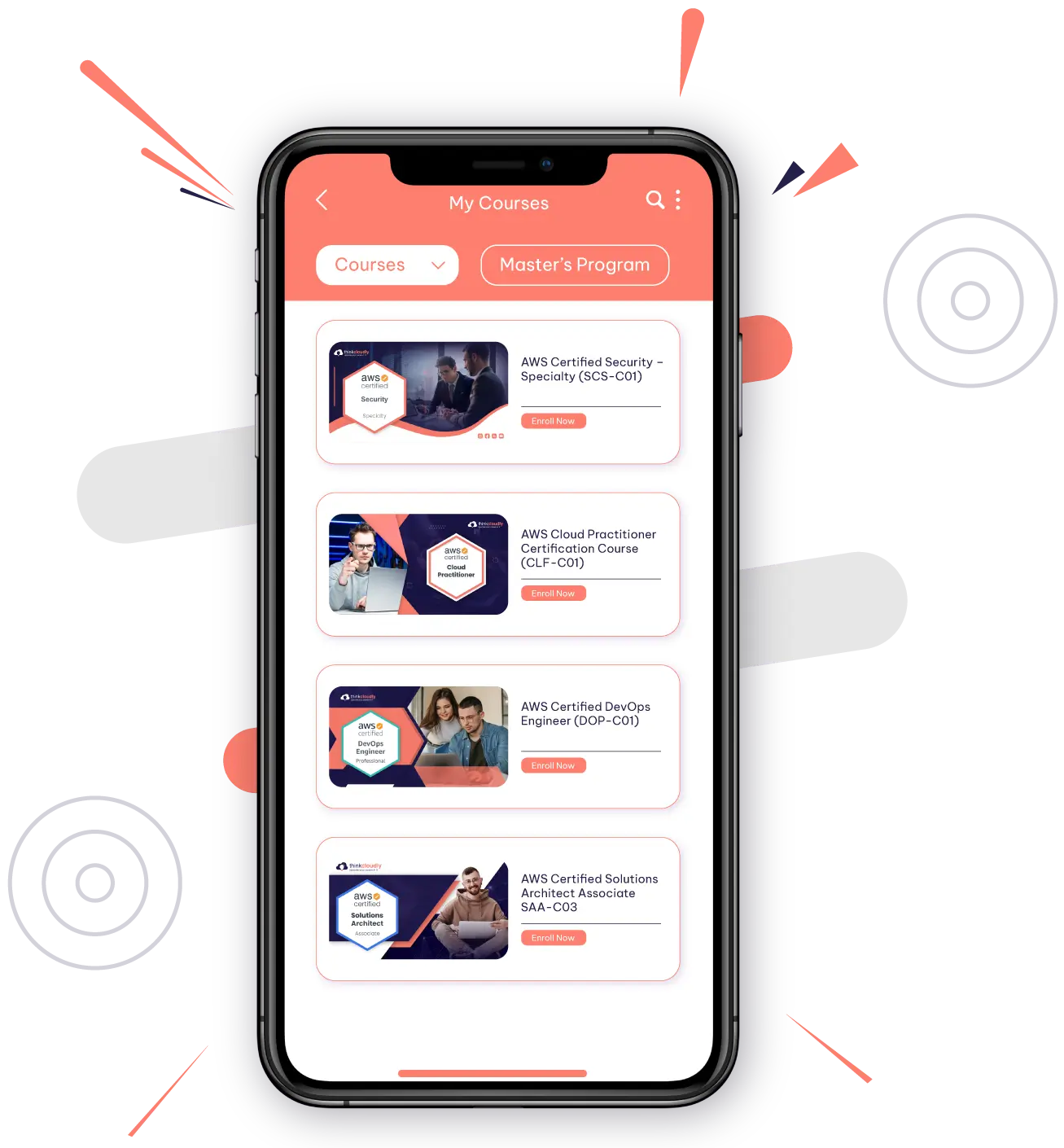The Complete Cyber Security Course : Hackers Exposed!
Become a cyber security expert and keep your digital information safe.
Defending networks, computers, and data from attacks, damage, and unauthorized access is the purpose of cyber security technologies, processes, and practices. The goal of this cybersecurity Course is to train professionals to recognize vulnerabilities, thwart attacks, and respond quickly to crisis situations.
- 23k+ PROFESSIONALS TRAINED | 45+ HRS OF ONLINE TRAINING
- 35+ CYBERSECURITY SKILLS | 35+ HANDS-ON LAB PRACTICE

Play Video
Cyber Security Course Highlights
Thinkcloudly provides the most comprehensive and one of the best cyber security certifications for beginners. We provide hands-on training in ethical hacking, cryptography, computer networks, application security, identity & access management (IAM), vulnerability analysis, malware threats, sniffing, SQL injection, DoS, session hijacking, and various security practices that businesses need to follow.
As per studies global cybersecurity workforce will grow by nearly 3.5 million by 2025. Therefore, now is the best time to learn and make your career as Certified cyber security expert!
- Instructor Led Trainings
- Life-time access to Course Material
- Gain Industry Experience
- Certification of completion
- Learn Anytime Anywhere
- Live Sessions with Industry Experts
- 24*7 Help & Support
- Hands On Experience
CyberSecurity Course Learnings
Implementing security measures and controls.
Understanding cyber threats and vulnerabilities.
Conducting penetration testing and ethical hacking.
Configuring firewalls and intrusion detection systems.
Continuously updating skills and knowledge on emerging threats.
Cyber Security Course Curriculum
Module 1: Introduction to Cyber security & Ethical Hacking
Topics:
- Introduction to Cyber Security
- Cyber Security Principles
- Cyber Security Architecture
- Cyber Security Governance
- Security Auditing
- Compliance and Regulatory Framework
- Introduction to Ethical Hacking
- Phases of Ethical Hacking
- Cyber Kill Chain
- Types of Malicious Code
Hands On:
- Footprinting a website using tools
- Gathering information about Domain through tools
- DNS Footprinting using DNS Interrogation Tools
Module: 2 Linux
Topics:
- Introduction to Operating Systems
- Understanding Linux, Components, Features & Architecture
- Linux Distributions
- Linux Editors
- Linux vs. Windows
- Linux vs. macOS
- Common Linux Commands
- Why Linux?
- Merits and Demerits of Linux
- Conclusion
Hands on :
- Practical on different commands
Module: 3 Cryptography
Topics:
- Threats
- Security Goals
- Encryption & Decryption
- Cryptography
- Types of Cryptography
- Hash Functions
- Ciphers
- Public Key Infrastructure (PKI)
Hands on:
- Generating and identifying hashes
- Signing a file with digital signatures
- Attacks on cryptosystems
- Cryptography + Cyber Security
Module: 4 Computer Networks & Security
Topics:
- Definition of Computer Network
- Basic Terminologies of Computer Networks
- Types of computer network
- Computer Networks – Architecture
- Layered architecture
- OSI & TCP/IP Layers
- Network Scanning & Enumeration
- Common Network Threats/Attacks
Hands on:
- Identify the Network Routes in the System
- DNS lookup and reverse lookup
- Network Path tracing
- Network Analysis
- Network scanning
- Enumeration
Module: 5 Application and Web Security
Topics:
- What Is A Web Server?
- Web Server Architecture
- How Web Servers Work?
- What Is Web Security?
- Web Server Attacks
- Countermeasures & Patch Management
- Difference Between Websites & Web Applications
- Web Application Architecture
- Web Application Attacks
Hands on:
- Capturing session ID with Burp Suite
- Local File Inclusion on bWAPP
Module: 6 IdAM (Identity and Access Management)
Topics:
- What is an IAM?
- What is an Identity?
- Authentication & Authorization
- How Does IAM Work?
- Regulation of access
- Password protection
- Identity theft
- IdAM (Identity and Access Management) – Hands-On
- Adding and granting permissions to users in Linux
Hands on:
- Adding and granting permissions to users in Linux
- Identifying phishing websites
Module: 7 Vulnerability Analysis & System Hacking
Topics:
- What Is a Vulnerability?
- Vulnerability Assessment and Process
- Types of Vulnerability Analysis
- Vulnerability Management Lifecycle
- Vulnerability Assessment Tools
- Vulnerability Scoring Systems
- Vulnerability Assessments Report
- System Hacking
- Scan and Find the Vulnerabilities with Tools
- Password Breaking
- Keyloggers or Capture Keystrokes
Hands on:
- Scan and Find the vulnerabilities with tools
- Password Breaking
- Install keyloggers and capture keystrokes
- Hacking Labs
Module: 8 SQL Injection
Topics:
- What is SQL?
- What is an SQL INJECTION ?
- Attack Intent
- Real World SQL injection Attacks
- Working of SQL injection
- IMPACTS OF SQL INJECTION
- In-Band SQLi
- Blind SQL Injection
- SQL Injection — Out-of-Band
Hands – on
- Bypass Authentication using SQL Injection
Module: 9 Malware and Sniffing
Topics:
- What is a Malware?
- Common Types Of Malware
- Protection Against Malware
- Real Cases Of Malware Attacks
- Sniffing
- Types Of Sniffing
Hands – on
- Create a trojan by using msfvenom
- Sniff network packets Using Wireshark
Module: 10 DoS/Ddos attack and Session Hijacking
Topics:
- DDoS/DoS Attacks
- What are the signs of a DDoS/DoS Attack?
- Types of DDoS Attacks & Detection Techniques
- What is a Session?
- Session Hijacking
- How Session Hijacking Works – Techniques, Types
- Session Hijacking Using XSS
- How Can You Prevent Session Hijacking?
- Intrusion Detection Systems (IDS) & Types
- What is a Honeypot & How it works?
Hands on:
- DoS Attack using LOIC Tool
- Cross-site Scripting attack
- Demonstration on cookie stealing
- Hijacking
Module: 11 Email and Social Engineering
Topics:
- What is Social Engineering?
- Why hacker use Social Engineering?
- Typical goals
- Types of Social Engineering Attacks
- How can you protect yourself from social engineering?
Hands-On:
- Analysis of Phishing mail
- Demonstrate social engineering attack
Module: 12 Threat Detection and Response
Topics:
- Important Terms- Event, Alerts, Incidents
- SIEM
- What is a Threat?
- Threat Detection and Response (TDR)
- Importance of Threat Detection and Response
- How does threat detection and response work?
- Threat detection and response process
- Incident
- 6 Phases of the Incident Response Lifecycle
- Threat Hunting
- Managed Detection and Response (MDR)
Hands-on:
- Demonstrate any SIEM tool
Training And Package Fee
Training Fee
Designed to get you trained with the core knowledge.
$999.00
- Online Live Training
- Live Projects
- Resume Building
- LinkedIn Grooming
- Profile Marketing
- Mock Interview Sessions
- Certificate Assistance
Job Seeker's Program Fee
Designed to make you job ready with knowledge, experience, and grooming.
$1400.00 $1150.00
- Online Live Training
- Live Projects
- Resume Building
- LinkedIn Grooming
- Profile Marketing
- Mock Interview Sessions
- Certificate Assistance
One-On-One Training Course @ $1499
- Personal Instructor
- 24*7 Admin Support
- Personalized Study Plan
Cyber Security Course Outcomes
Mastery of network security principles and protocols.
Proficiency in identifying and mitigating cyber threats.
Experience in security risk assessment and management.
Enhanced cybersecurity awareness and risk management.
Expertise in threat modeling and risk analysis methodologies.
What roles you can play?
Security Analyst
Monitor and analyze security threats, implement security measures, and respond to incidents.
Security Engineer
Design, implement, and manage security infrastructure, including firewalls, VPNs, and intrusion detection/prevention systems.
Security Consultant
Provide expert advice on security solutions, risk management, and vulnerability assessments for organizations.
Penetration Tester
Identify and exploit vulnerabilities in systems to assess and improve overall security.
Incident Handler
Respond to and manage security incidents, including detection, containment, eradication, and recovery.
CyberSecurity Consultant
Offer comprehensive cybersecurity services to clients, including risk assessments and security strategy development.
Know before you Start
Introduction to Cyber Security Course with Thinkcloudly
Thinkcloudly’s Cyber Security Training Course provides access to numerous classes including topics like ethical hacking, cryptography, computer networks & security, application security, IAM (identity & access management), vulnerability analysis, malware threats, sniffing, SQL injection, DoS, and session hijacking. With a student who goes through the Cyber Security certification program, they will learn these important security practices and increase their employability.
What jobs I can apply for after completing this Cyber Security Course?
The top Cyber Security Jobs titles are:
Why enroll for Cyber Security Training Course?
Why Cyber Security Certification Course from Thinkcloudly?
What Skills are Covered in this Thinkcloudly Cyber Security Course?
Skills You Will Gain
SOC
SIEM
Networking
IAM
Coding
WAF
Firewalls
OSI Model
Cryptography
Malware
Penetration
Hacking
Certification Overview
What online cyber Security Certification programs are considered to be the best?
Cyber Security Certification is a constantly changing field, which results in high demand for certain skills across industries. Certifications add professional value to individuals, however some are more valuable than others. These are the certifications that hold the most appeal for cyber security professionals.
Keeping up with technology advancements is also a constant challenge in cybersecurity. The following are a few of the most popular Cyber Security certifications you can find online, with some certifications testing you more rigorously than others.
Does Cyber Security Training require coding?
While coding skills are not necessary for entry-level cyber security jobs, they may be required for mid- or upper-level positions.
Can I Complete Cyber Security Certification in 6 months?
As of right now, you can learn all the fundamentals in Cyber Security Training through online resources and courses, which will take anywhere from six months to a year.
Is Cyber Security Course worth IT?
It may be a good idea to also get Cyber Security Training, if you’re interested in starting with a good Cyber Security jobs that will pay well right off the bat. The median annual salary is around $90,000, with higher salaries available in major metropolitan areas like San Francisco.
Is Cyber Security Course easy or hard?
In spite of difficult concepts, like cryptography, or areas that require more technical knowledge, Cyber Security Certification is one of the few fields in the tech world that does not require strong technical background.
Career Services
Job Assistance
Interview Preparation
Profile Building
Template is not defined.
Template is not defined.
Template is not defined.
Technology Use Cases
JPMorgan Chase
JPMorgan Chase emphasizes cybersecurity to safeguard financial information and transactions, implementing rigorous security controls and investing in skilled professionals.
Microsoft
Microsoft prioritizes cybersecurity to protect its software, services, and customer data, employing advanced threat detection and encryption technologies.
Our Students Work at












Cyber Security Course Reviews
FAQs
What is the payment procedure?
We accept all major credit and debit cards from leading banks. For any assistance, please contact Thinkcloudly Customer Support.
Which course or Plan is best for me?
We offer a variety of ways to learn about the cloud, from quick hands-on labs to technical deep dives. You can ask our experts to help you from their industry experience if you are uncertain which course or plan to choose.
Would a Demo Session be available before I enroll?
Certainly, you can set up a free demo session, although if you’ve already viewed any sample recordings, you won’t need to look further. The enrollment process signifies a mutual commitment between you and us where you commit to be a good learner and we pledge to provide you with the best possible learning environment. A key part of your learning takes place in our sessions, which are supported by experienced instructors, dedicated Personal Learning Managers, and interactions with your peers. Get the full learning experience, and not just a demo.
When will I be able to access the Learning Content?
You will receive access to the LMS immediately after enrolling and will have it for the rest of your life. You will have access to all previous class recordings, PPTs, PDFs, and assignments. In addition, you will have instant access to our 24×7 support team. You can start learning as soon as possible.
I missed a class, what do I do?
At Thinkcloudly, you’ll never miss a lecture! You can view the recorded session in your LMS anytime also the missed session can be attended in another live batch.
Who are the instructors at Thinkcloudly ?
Teachers and tutors at Thinkcloudly are industry veterans with great experience.















